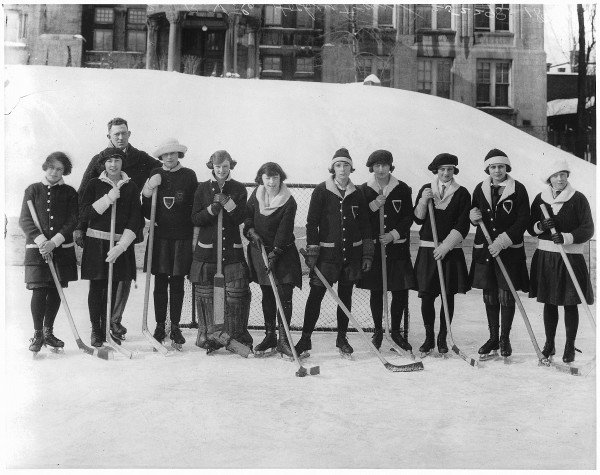Opened in 1899, Royal Victoria College, became the women’s arm of McGill University in Montreal. University level lectures had been offered for women at McGill beginning in 1881, and in 1884, Rosalie McLea, Octavia Ritchie, Alice Murray and Helen Reid became the first four women admitted as students to McGill University. With their entrance, McGill became the first University in the province of Quebec to admit women as students.
While women’s hockey was first played at McGill in 1896, it wasn’t until the foundation of Royal Victoria College that women’s hockey took a permanent hold at the school.
Predominantly, hockey was played between the “years” at the school with seniors, juniors, and first year students icing rosters. By the early 1900s, the game expanded outside the boundaries of Royal Victoria College. Specifically, teams were eventually formed by students at McDonald College, another arm of McGill located on Sainte-Anne-de-Bellevue, and when the school was founded in 1912, by the McGill School of Physical Education’s women’s hockey team.
The teams predominantly played on outdoor rinks making weather a deciding factor over the schedule. By 1923, the sport of women’s hockey was booming, including the formation of an amateur league for women in Montreal, and intercollegiate play.
“The formation of the Montreal Ladies’ Amateur Hockey League, consisting of the Y.W.C.A., Macdonald College, Teachers’ Club, McGill School of Physical Education and the R.V.C. resulted in some very close games, the “Teachers” coming out on top,” McGill’s 1923 Yearbook read.
“Interclass matches were organised as usual, with more than the usual success, the climax being reached when Juniors and Seniors clashed in a driving rain-storm. Undaunted by the hostile elements, a hotly contested battle took place from which the Seniors emerged with the championship, the score being 2-1.”
In 1923, a picked team of the top players from across McGill’s women’s teams was formed to travel to face the University of Toronto. In front of a reported 3,000 fans, Toronto defeated McGill 4-0, a number that McGill publications claimed was due to the stellar goaltending of Royal Victoria College netminder Lorna Kerr.

Toronto, McGill, and soon Queen’s would become regular opponents, competing for the William Beattie Ramsay Cup. McGill’s varsity team met Queen’s for the first time in 1926 with Queen’s winning 2-1 in overtime. In 1928, the two schools met again with Queen’s playing a combined roster from Royal Victoria College and the McGill School of Physical Education. The opponents played to a 0-0 tie, and followed it up in 1929 with a 1-0 loss to Queen’s.
McGill’s teams, including those from Royal Victoria College typically played on an outdoor surface referred to as the “Hollow Rink.” By the 1931 season, the Royal Victoria College team was not only practicing outdoors, but they had plans to extend their season into the spring by playing at the Montreal Forum, which at the time was home to the NHL’s Montreal Canadiens and Montreal Maroons. Moving into the mid-1930s, Mount Royal Arena became a regular home to RVC’s women’s hockey teams.
The team in the early 1930s was coached by Kenneth Farmer, who attended McGill himself playing for the Redmen, and in 1936 was Canada’s second leading scorer winning silver at the 1936 Olympics. The 1934 season saw the RVC team, nicknamed the Farmerettes for their coach at the time, brimming with popularity as “The purpose this year has been to create more interest in hockey rather than to have a picked number of good players. A record number of girls has been turning out to the weekly practices, about twenty-eight enthusiastic players reporting each week.”
The team however did pick a roster, featuring standouts Sheila Ritchie, Beverly Hughes, Margaret McCuaig and Edith Walbridge who played a pair of intercollegiate games beating Bishop’s University 8-1 and finally proving victorious against Queen’s winning in Kingston 3-1. Royal Victoria College continued their representation of McGill against other institutions including Bishop’s, Stanstead College, Queen’s University and MacDonald College. The RVC roster reigned supreme among their Quebec competitors throughout the decade, rarely losing a game. In 1936 that included 2-1 and 11-0 wins over Stanstead College, a game in which Ruth Schnelby impressed onlookers, including the Quebec, and Montreal City and District League champion Montreal Maroons who watched the game, by scoring a hat trick. Be
By the end of the 1930s, the team was under guidance of a woman as coach with former Royal Victoria College standout Jean Buchanan stepping behind the bench. Buchanen had played defence for RVC for four seasons prior to moving into a coaching role. With
As the 1940s rolled around, weather conditions, and the impact of World War II were noticeable on McGill’s rosters. The team began practicing outdoors at the McTavish Street rink.
While many institutions, leagues, and organizations faltered in the 1940s, McGill’s women’s hockey programs remained active and viable. By the mid-1950s gaps started to form in women’s hockey, although intramural competition continued. But by the 1960s, the women’s ice hockey club was again “one of the most popular clubs on campus” drawing between 50 and 100 participants for intramurals, and a burgeoning intercollegiate circuit that now included teams from Queen’s, Toronto, McMaster, Western, and Guelph.
McGill’s ability to maintain an almost constant presence in women’s hockey for well over a century is another testament to the interest level the sport holds in Quebec.

